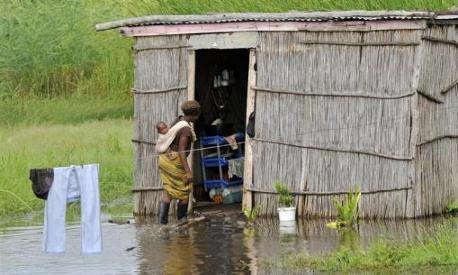Southern Africa farmers face heavy flood losses
By Fidelis Zvomuya
23 Feb 2011 UPINGTON, South Africa (AlertNet) – Temba Mduli’s fields resemble a vast lake, studded with treetops and half-submerged buildings. Once-green corn, soya beans, potatoes and sunflowers have been turned yellow by some of the worst flooding to cut through northern South Africa in years. “I will be lucky just to get fodder out of the bad parts,” he says, as his two John Deere tractors sit nearby, submerged to their steering wheels. “That’s what I’m left with after Mother Nature wreaked havoc here.” Higher than normal rainfall has brought widespread flooding to eight of South Africa’s nine provinces, hitting the country’s economy and provoking fears of food price hikes. With 33 districts declared disaster areas, more than 20,000 people are in need of assistance, 8,400 of them homeless or displaced, local officials say. In Mdluli’s home district of Benede Oranje in Northern Cape province, the Vaal River has cut a swath of destruction, soaking fields, engulfing roads and shutting down transport hubs. Leafy crops like lettuce have been shredded by high winds. “This is a devastating loss,” the farmer says. “The water came so fast that there was no time to evacuate treasured farm implements and household goods to higher ground.” He estimates the damage on his 25 hectares (62 acres) of land will run to $50,000. This year’s rainy season has brought abnormally heavy rainfall to countries across southern Africa. According to Washington Zhakata, national coordinator of Zimbabwe’s Climate Change Awareness Programme, the unusual rains may be driven by La Nina, a climatic pattern believed to have contributed to recent severe flooding in Australia, Brazil and the Philippines. … Farming in South Africa is a business with high costs and narrow profit margins, according to Jo Gondo, president of the National African Farmers Union (NAFU). Gondo says he expects some farmers may be forced to give up their land because insurance will not fully cover their losses, and government assistance is insufficient to make up the difference. … The United Nations Food and Agriculture Organisation (FAO) says thousands of hectares of agricultural land and crops in southern Africa have been damaged by floods and heavy rains in recent weeks. The skies show no sign of giving relief, with above-average rainfall forecast for the next few months. “With the rainy season still only halfway through, and with the cyclone season due to peak in February, several agricultural areas along rivers in southern African countries remain at high risk of flooding, including portions of Botswana, Lesotho, Mozambique, Namibia, Zambia, Zimbabwe and South Africa,” the FAO warned in a statement. Localised crop losses have been reported near rivers in southern and central Mozambique. The government has declared a red alert for these areas as water flows in major rivers remain above safe levels. Mozambique has recorded 13 flood-related deaths, and thousands of people have fled their homes for higher ground. The prospects of further flooding are raising concerns about the food security of affected people in poorer parts of the region. “Food insecurity levels are already critical in the affected areas of some of these countries and floods will only further worsen the ability of poor farmers to cope and feed their families in the coming months,” said Cindy Holleman, FAO’s regional emergency coordinator for southern Africa. The FAO is working with regional and national early warning systems to monitor developments in major river basins and to assess the impact of flooding on food crops. …
